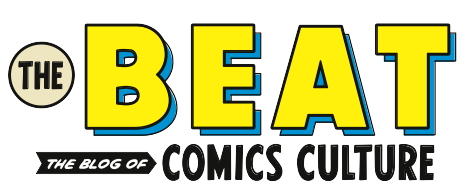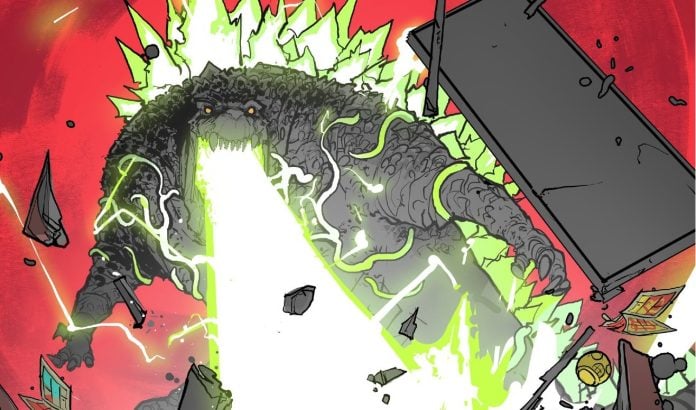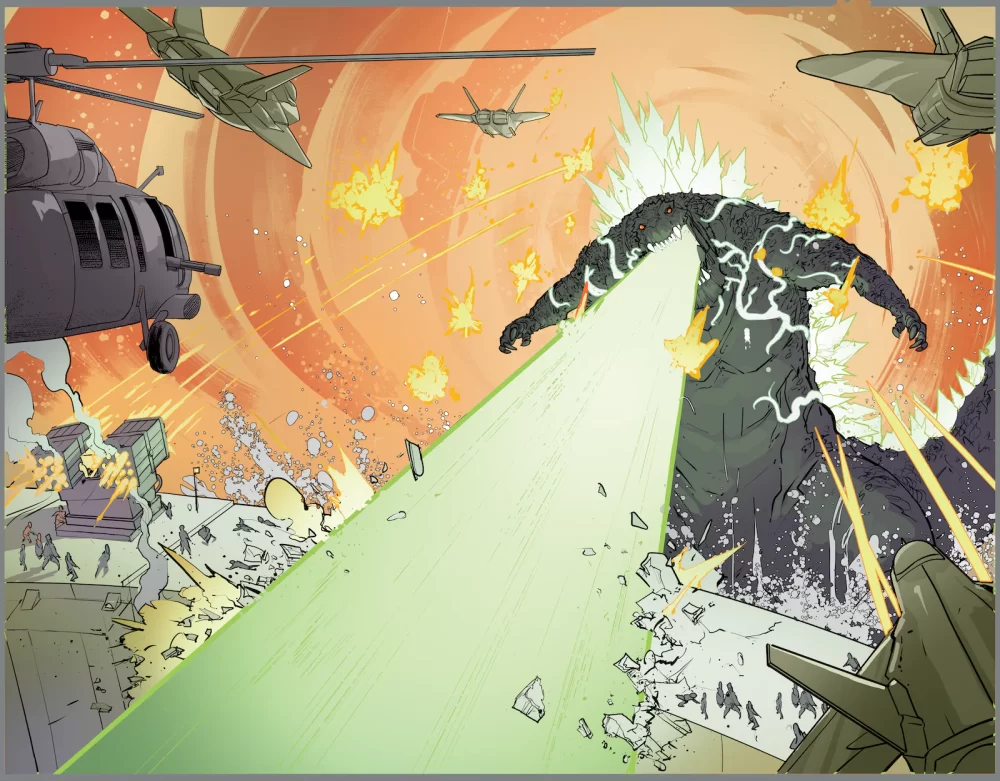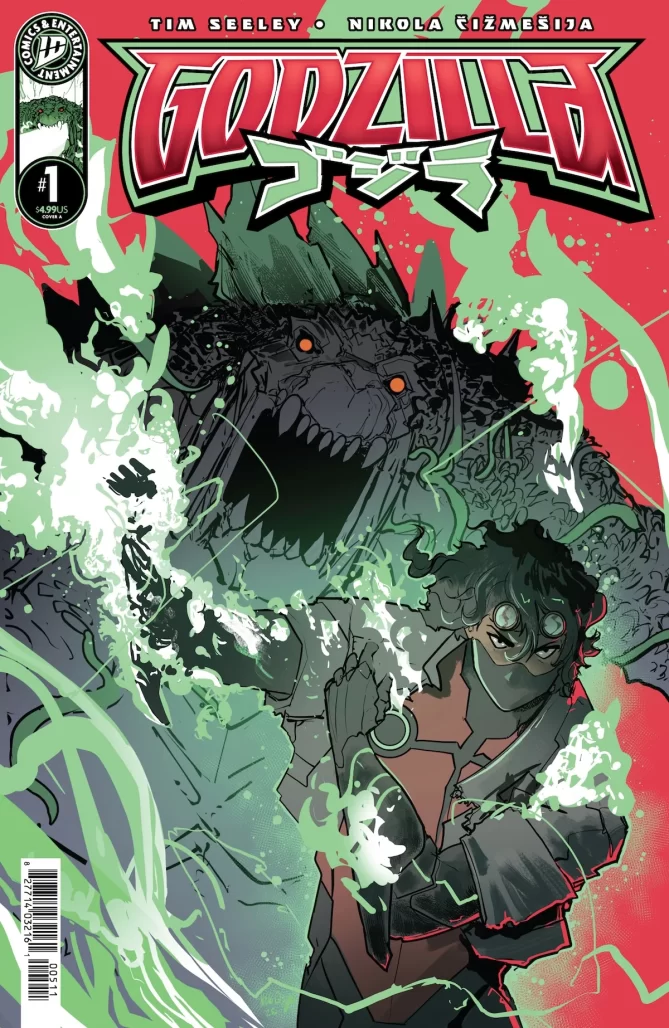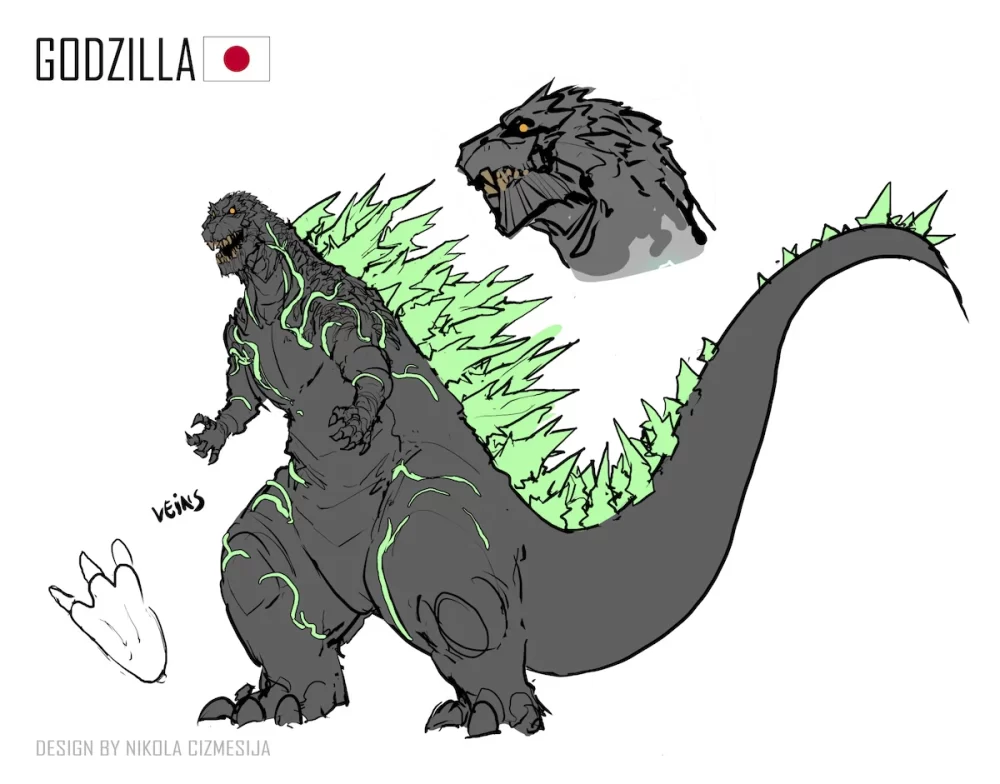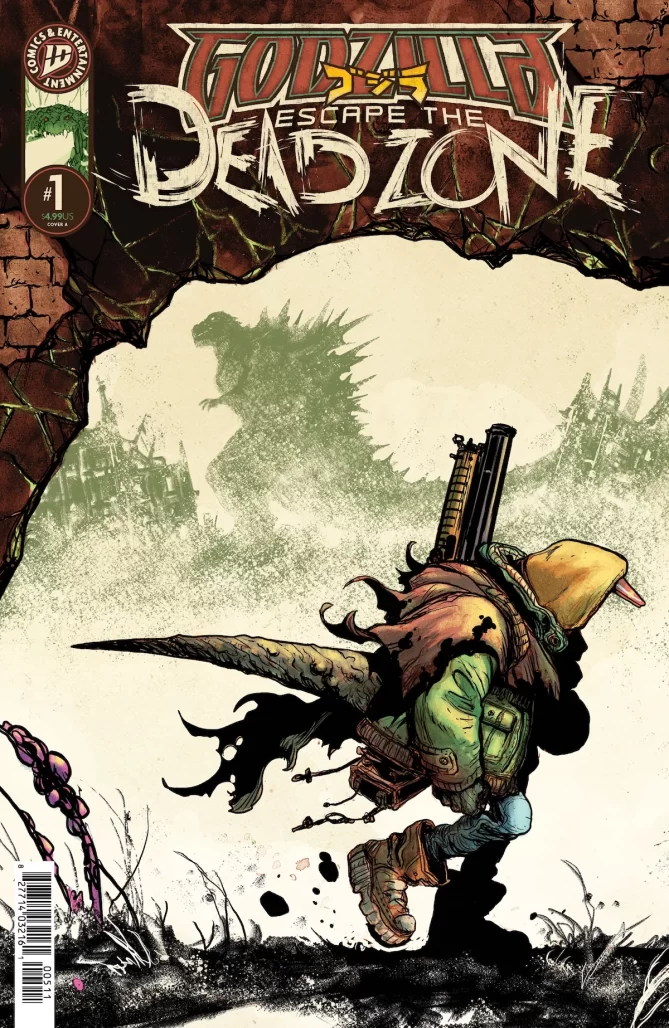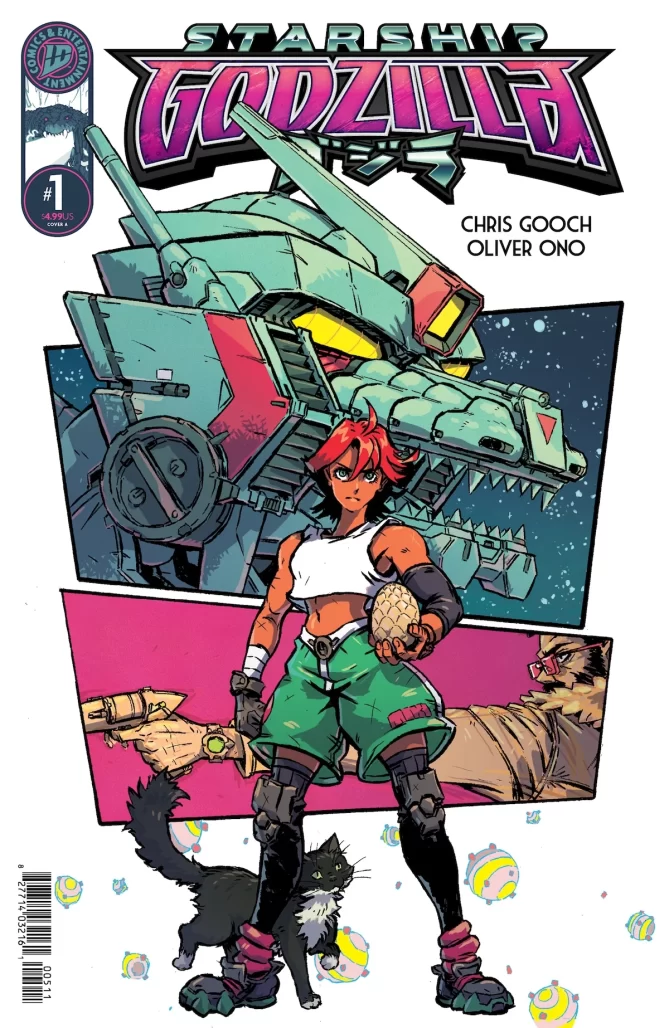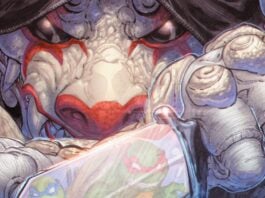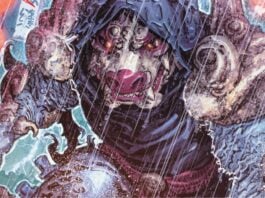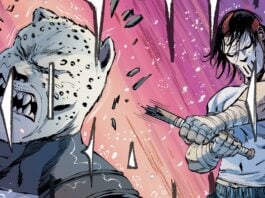It’s no exaggeration to say that 2024 was a major year for Godzilla. Not only did last year mark the 70th anniversary of the iconic kaiju but the franchise won its first Oscar for Best Visual Effects for Godzilla: Minus One. The King of the Monsters is not slowing down anytime soon, especially in comics with the launch of a new shared universe line of comic book titles from IDW. Dubbed the “Kai-Sei Era,” fans can look forward to a new ongoing series, simply titled Godzilla, by writer Tim Seeley and artist Nikola Čižmešija next month. The Kai-Sei Era will continue to expand in the coming months with with the post-apocalpytic Godzilla: Escape the Deadzone book from the creative team of writers Ethan S. Parker and Griffin Sheridan and artist Pablo Tunica in August followed by Starship Godzilla, a space opera book by writer Chris Gooch and artist Oliver Ono arriving in October.
The Beat had the pleasure of interviewing via email IDW editor Jake Williams to get the skinny on the launch of the Kai-Sei Era. During our discussion, Williams revealed the inspirations for this new design of Godzilla, potential aliens from the lore that fans can expect, and much more!
Taimur Dar: Until this Kai-Sei Era line of Godzilla comics from IDW, I was not aware that the Godzilla franchise was broken into several different eras reflecting a characteristic style. Apparently, a number of them are named after the Japanese emperor during production. So I’m curious how “Kai-Sei” was settled upon for this IDW comics line?
Jake Williams: We’re trying to do everything we possibly can to get the word out that the Kai-Sei Era is new and different–that it’s a seismic shift for Godzilla comics. A key part of that is the Kai-Sei Era designation. Fans use those era titles to separate out the different incarnations of the character–so what better way for us to communicate to fans that the new IDW Godzilla is an entirely different beast.
Kai-Sei is the name of the energy in our universe–the thing that really separates what we’re doing from other variations–so it seemed the most fitting. Kai-Sei is the reason Godzilla’s heat ray is green, it’s the source of our protagonist’s powers, and it’s the catalyst for all mutations in our world. It also happens to already sound like Heisei, the name for the second era, so the connective tissue is clear.
Taimur Dar: Obviously, Godzilla has made many different designs and looks over the decades. While the infamous 1998 American film has its fair share of detractors, I have a soft spot for its iguana-like design. This Kai-Sei Era Godzilla sports a new design by Nikola Čižmešija that is still recognizably Godzilla but new twists, most notably the glowing green veins. What was the process of reimagining this version of the King of Monsters?
Jake Williams: We were almost ready to start art for issue 1 when we officially got word from Toho that we were clear to redesign Godzilla. After we knew that we could…we knew we had to. To have your own take on the franchise, you have to have your own take on Godzilla. It’s a calling card for your era.
With that in mind, we set out to craft a design that would immediately clue people in to what this new era had in store. Nikola got to work on some crazy takes on the character, and then we worked with Toho to refine and make sure the core elements of Godzilla were intact.
For the headshape we turned to Pablo Tunica, our artist on Escape the Deadzone, who had done this really fantastic sketch of Godzilla that had a lot of the Kai-Sei Era head already there. It was mean, animalistic, and had this fantastic jaw line–almost akin to Thanos. It screamed ‘villain’ in a way some friendlier Showa/Heisei based Godzilla depictions don’t. Allowing the monster to be terrifying in an entirely new way, for a new generation of readers.
Taimur Dar: Godzilla as a franchise has always been popular, but there has been a noticeable comeback the last few years. Why do you think Godzilla resonates so much now at this specific point in time for our culture?
Jake Williams: For one thing, technology has really caught up to the concept. Legendary, and more recently Toho with Godzilla: Minus One, are able to depict Godzilla in a way that makes the monster feel REAL. I think it’s impossible to walk out of one of those films without your imagination lit up.
Taimur Dar: Godzilla is a character and property that even if you’ve never watched, you at least know the basic concept. What’s your personal history with Godzilla? Were you already a fan steeped in the lore before becoming an editor for the Godzilla comics? Or have you become a fan and grown a deeper appreciation of the franchise since becoming the editor?
Jake Williams: I had a fairly standard relationship with Godzilla. Like just about everyone else, I went out to see the Legendary Monsterverse movies as well as Godzilla: Minus One when it came out. There hasn’t been a Godzilla movie released in my lifetime that I didn’t see in theatres–but it wasn’t until I got the job as editor that I went back and checked out the earlier films.
These comics are aimed at huge Godzilla fans–but they’re also aimed at the sort of fans I was. People who think Godzilla is awesome, but haven’t yet felt a need to pick up any comics featuring the character.
Taimur Dar Shared universes can be double edged words, especially in comics. In recent years, I think the launch of the Energon Universe from Skybound and Absolute Universe from DC have been phenomenal successes because each book connects to the others without readers feeling lost or compelled to buy every book. What can you say about the balance of connectivity and accessibility for each book in this Godzilla Kai-Sei Era line?
Jake Williams: We aimed to create a world for these books that felt generative, not restrictive. We’re not trying to create lore that you have to keep track of–we’re trying to make a playground for stories. The concepts we’re introducing in this line are meant to spark imaginations and create fertile ground for future storytelling. While the characters and concepts in these stories will eventually cross over–they also all function on their own. One of the three stories is happening way out in outer space–and of the two that take place on Earth, there’s a literal wall separating them.
Taimur Dar: One of the major things teased in this Kai-Sei era of comics is a half-kaiji half-human hybrid. The idea of hybrid human/monster characters is definitely something other franchises have played with, such as in Alien Resurrection. But it seems like this is something different. What can you tease about what makes this human/kaijiu hybrid unique?
Jake Williams: For starters, it’s incredibly unique in the world of Godzilla. This isn’t something Toho has ever put into Godzilla media before, so that makes it feel really exciting. This is a character that’s able to interact with the kaiju of the Godzilla universe in a way that no human character has been able to do before–which means it’s an entry point for readers to interact with their favorite kaiju in a way that hasn’t been done before.
We also get a lot from this character in an emotional sense. If Godzilla is a representation of disaster, this character is a representation of how disasters affect humanity. It’s our comic booky way to show how experiencing trauma and devastation changes you.
Taimur Dar: Starship Godzilla is an interstellar book about Earthlings traveling outer space in a Mechagodzilla encountering alien races. Should hardcore fans expect some established alien races from the Godzilla franchise to appear like the Exif, Kilaaks, or Nebulans?
Jake Williams: One thing I have to set the record straight on: the human-appearing characters in Starship Godzilla aren’t from Earth. Just like Star Wars or other space-faring stories, there are human-like beings around the galaxy.
As far as other alien races–we’re going to see all kinds! The Xiliens play a MASSIVE role in our story, and there’s a Simian literally on the crew. And as the book continues on, we’ll certainly see even more of those aliens you mentioned.
Taimur Dar: It’s hard to believe that IDW first acquired the Godzilla rights back in 2010. But it seems since IDW signed the new licensing deal with Toho back in 2020, there’s been a renewed creative energy whether it’s Louie Joyce’s Godzilla: Skate or Die or Godzilla’s Monsterpiece Theater from Tom Scioli or countless other projects. What’s been the key to reinvigorating IDW’s Godzilla comics?
When IDW first acquired the rights to make Godzilla comics, I think there was a general vibe that we wanted to replicate the sorts of stories that fans had come to love in Godzilla movies. As time went on, an understanding grew that we should instead lean into telling Godzilla stories that can ONLY be told on the pages of a comic. We also finally started to understand that Godzilla is a force of nature that can exist inside of any type of story. Godzilla is a perfect character to give to creators and allow them to tell a kaiju story in their own unique voice in style. Godzilla is still Godzilla, whether the monster is surrounded by skater punks or literary heroes.
